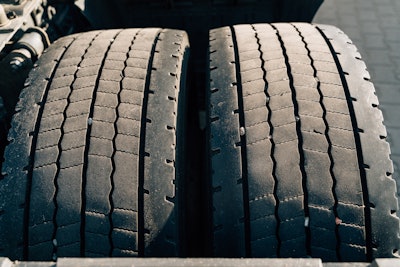
While the wheel hasn't changed much in millions of years, truck and trailer tires can provide a mountain of data to a technician who knows how to interpret it – and you don't even have to plug in, connect or log on to get the information.
With more than 100 years of accumulated maintenance experience and hard science as a guide, a good technician examining a tire can discern a wide array of problems quickly, such as questionable driver behavior, alignment issues, worn components and improperly spec’d tires.
Just like walking on an injured foot or leg for an extended period can cause irregular wear on a shoe, the same thing too can happen to tires. Whether it’s a toe problem or a camber problem, or if it’s a drive axle misalignment problem, it’s going to show up in your tires.
Tires represent a significant investment for fleets. It's usually a motor carrier's third highest expense behind salary and fuel, and when it comes to tire wear drivers are a fleet’s first line of defense, according to Michelin. All drivers should include a comprehensive tire examination in pre- and post-trip inspections. During those inspections, they need to get “up close and personal,” rubbing their hands on the tires to check for any feathering, cupping or diagonal wear.
There also might be a more personal reason for drivers to monitor tire wear, because tires can expose bad driving habits and their own poor tire care. Tires easily can indicate driver practices such as high-power or jackrabbit starts, brake skids or lack of regular inflation.
If you have spec’d a tire improperly, you will quickly see an increased wear rate, says Continental. If a fleet has selected a tire that isn’t right for the application – such as a regional tire optimized against cutting and chips that is being used in a slow wearing application – tramline wear would be evident.
“Tires are getting more specialized all the time, according to Goodyear. We now have tires that are best suited for high-scrub applications – a great example would be a school bus – that are constantly turning left and right, with lots of starts and stops. The tires go through a lot of scrubbing in all those tight turns. Goodyear designs high-scrub tires with a tread compound that wears “as well as it can in that situation,” Goodyear says. “It’s going to resist the scrubbing. If you didn’t have that tire on, you’re probably going to burn your tires off pretty quickly because you have the wrong tire for the application.”
Tires, like vehicles, have become very application-specific in recent years, according to Double Coin. Different patterns, sizes, designs and components of a tire offer the vehicle the best productivity and efficiency in a specific application. If mismatched, many times the tire, and sometimes the vehicle, will show the results.
No matter how thorough a fleet’s inspection process, it’s not enough if drivers don’t act quickly to avert catastrophic tire damage when something unforeseen happens. If a truck has an air pressure monitoring system that warns of slow or sudden air pressure loss, the driver should pull over as soon as possible to prevent further tire damage – as well as potential damage to the truck or nearby cars. If no PSI monitoring system is available, it is difficult for a driver to do anything unless noise, vibration or altered performance is felt in the cab.
The bottom line? Not taking the time to examine tires – or ignoring the problems the tires are identifying – not only increases tire acquisition and replacement costs but also allows vehicle issues to get out of hand and become safety issues.
Diagonal wear
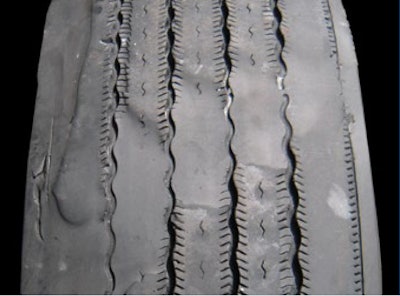 Michelin
Michelin
Thrust/scrub angle wear
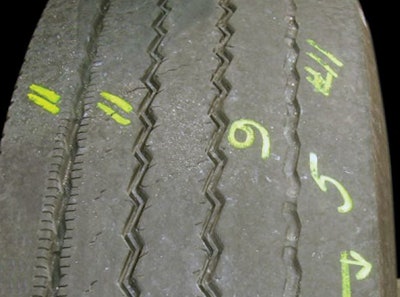 Michelin
Michelin
Similar to thrust angle wear, dog tracking occurs when a tractor’s rear axles are not aligned properly with the axles of the trailer it is pulling; the tractor is attempting to drive down the road in a straight line, while the trailer behind is attempting to track off a few degrees to the right or left. In severe cases, dog tracking can be so bad a driver on a straight road can see more of one side of the trailer in his rearview mirrors than the other. Signs of dog tracking easily are confused with thrust angle wear. The best way to determine the correct problem is to evaluate the vehicle’s driving characteristics: If the truck pulls constantly in one direction, the problem is in the mounting of the drive axles. If the vehicle wanders all over the road, the problem is most likely an alignment issue in the trailer axles.
Tandems should be square when they’re mounted properly on a vehicle; they should be perpendicular to the frame and parallel to each other. Scrub comes into play when one of the axles is not parallel to the other axle. So a tire on one side of the vehicle is rolling in a larger diameter than on the other side, causing the vehicle to attempt to turn in circles, creating an extremely tortuous condition for the tire in question. Scrub angle problems generally show up as diagonal wear across the tread of a tire. But diagnosing the condition can be tricky as worn axle components also show up as diagonal wear.
Sidewall wear
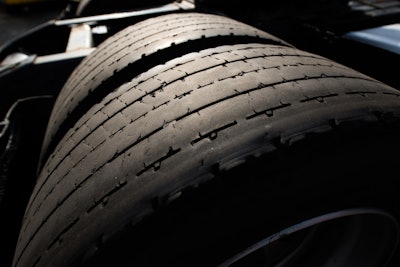
Feather wear
 BFGoodrich
BFGoodrich
Camber
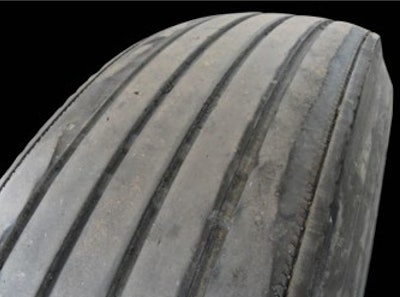 BFGoodrich
BFGoodrich
Cupping wear
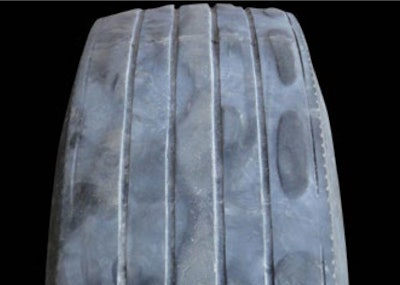 BFGoodrich
BFGoodrich
Flat-spotting
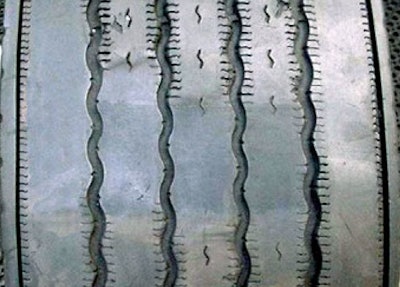 BFGoodrich
BFGoodrich







